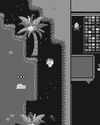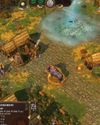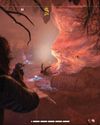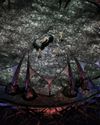
In Shyish, the Realm of Death, Nagash the Great Necromancer moulds the souls of the deceased into his personal army. Cursed with new forms that reflect their mortal sins, he creates endless hosts of wailing, suffering spirits known as the Nighthaunt. And then he sends them all to capture my bloody control points.
When this real-time strategy game set in the mythic fantasy world of Warhammer Age of Sigmar was announced, only two of the game's four factions were revealed: the shining warriors of the Stormcast Eternals, and the vicious, swamp-dwelling Orruk Kruleboyz. As I play through two of the game's campaign missions, I get to meet a third- and it's not a friendly introduction. As I attempt to hold three objectives - the bases of spectral chains I need to break to retrieve a powerful artefact - the Nighthaunt throw themselves at my heroic Stormcast in relentless waves.
This seems to be what, at its core, Realms of Ruin is all about: objective control. Though the two campaign missions I play are quite different conceptually-one, pushing into Orruk-controlled territory, the other holding out against the aforementioned barrage of ghosts - they both essentially come down to seizing and holding ground against repeated enemy attacks. With little in the way of base-building or economy management, beyond being able to plop one of a limited set of structures on points you control, the focus isn't on how you make your armies, it's on how you use them to dominate.
This story is from the {{IssueName}} edition of {{MagazineName}}.
Start your 7-day Magzter GOLD free trial to access thousands of curated premium stories, and 9,000+ magazines and newspapers.
Already a subscriber ? Sign In
This story is from the {{IssueName}} edition of {{MagazineName}}.
Start your 7-day Magzter GOLD free trial to access thousands of curated premium stories, and 9,000+ magazines and newspapers.
Already a subscriber? Sign In

A New Dawn - The rise, fall and rise again of PC Gaming in Japan
The so-called 'Paso Kon' market (ie katakana's transliteration of 'Pasonaru Computa') in Japan was originally spearheaded in the 1980s by NEC's PC-8800 and, later, its PC-9800.

MARVEL: ULTIMATE ALLIANCE
Enter the multiverse of modness.

SLIDES RULE
Redeeming a hated puzzle mechanic with SLIDER

GODS AND MONSTERS
AGE OF MYTHOLOGY: RETOLD modernises a classic RTS with care

PHANTOM BLADE ZERO
Less Sekiro, more Wo Long: Fallen Dynasty

STARR-MAKING ROLE
Final Fantasy XVI's BEN STARR talks becoming a meme and dating summons

THIEF GOLD
Learning to forgive myself for knocking out every single guard.

HANDHELD GAMING PCs
In lieu of more powerful processors, handhelds are getting weirder

FAR FAR AWAY
STAR WARS OUTLAWS succeeds at the little things, but not much else shines

FINDING IMMORTALITY
Twenty-five years on, PLANESCAPE: TORMENT is still one of the most talked-about RPGs of all time. This is the story of how it was created as a ‘stay-busy’ project by a small team at Black Isle Studios